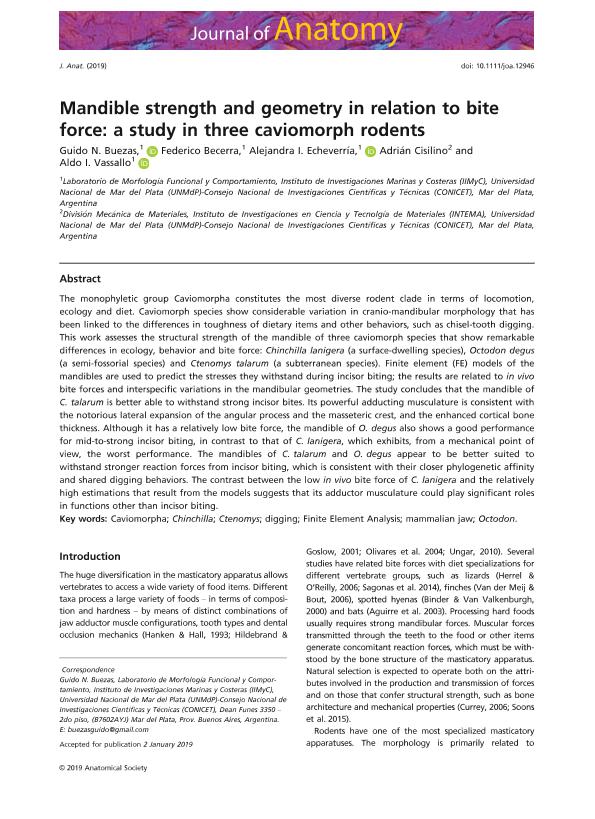Artículo
Mandible strength and geometry in relation to bite force: a study in three caviomorph rodents
Buezas, Guido Nicolás ; Becerra, Federico
; Becerra, Federico ; Echeverría, Alejandra Isabel
; Echeverría, Alejandra Isabel ; Cisilino, Adrián; Vassallo, Aldo Iván
; Cisilino, Adrián; Vassallo, Aldo Iván
 ; Becerra, Federico
; Becerra, Federico ; Echeverría, Alejandra Isabel
; Echeverría, Alejandra Isabel ; Cisilino, Adrián; Vassallo, Aldo Iván
; Cisilino, Adrián; Vassallo, Aldo Iván
Fecha de publicación:
02/2019
Editorial:
Wiley Blackwell Publishing, Inc
Revista:
Journal of Anatomy
ISSN:
0021-8782
Idioma:
Inglés
Tipo de recurso:
Artículo publicado
Clasificación temática:
Resumen
The monophyletic group Caviomorpha constitutes the most diverse rodent clade in terms of locomotion, ecology and diet. Caviomorph species show considerable variation in cranio-mandibular morphology that has been linked to the differences in toughness of dietary items and other behaviors, such as chisel-tooth digging. This work assesses the structural strength of the mandible of three caviomorph species that show remarkable differences in ecology, behavior and bite force: Chinchilla lanigera (a surface-dwelling species), Octodon degus (a semi-fossorial species) and Ctenomys talarum (a subterranean species). Finite element (FE) models of the mandibles are used to predict the stresses they withstand during incisor biting; the results are related to in vivo bite forces and interspecific variations in the mandibular geometries. The study concludes that the mandible of C. talarum is better able to withstand strong incisor bites. Its powerful adducting musculature is consistent with the notorious lateral expansion of the angular process and the masseteric crest, and the enhanced cortical bone thickness. Although it has a relatively low bite force, the mandible of O. degus also shows a good performance for mid-to-strong incisor biting, in contrast to that of C. lanigera, which exhibits, from a mechanical point of view, the worst performance. The mandibles of C. talarum and O. degus appear to be better suited to withstand stronger reaction forces from incisor biting, which is consistent with their closer phylogenetic affinity and shared digging behaviors. The contrast between the low in vivo bite force of C. lanigera and the relatively high estimations that result from the models suggests that its adductor musculature could play significant roles in functions other than incisor biting.
Archivos asociados
Licencia
Identificadores
Colecciones
Articulos(IIMYC)
Articulos de INSTITUTO DE INVESTIGACIONES MARINAS Y COSTERAS
Articulos de INSTITUTO DE INVESTIGACIONES MARINAS Y COSTERAS
Articulos(INTEMA)
Articulos de INST.DE INV.EN CIENCIA Y TECNOL.MATERIALES (I)
Articulos de INST.DE INV.EN CIENCIA Y TECNOL.MATERIALES (I)
Citación
Buezas, Guido Nicolás; Becerra, Federico; Echeverría, Alejandra Isabel; Cisilino, Adrián; Vassallo, Aldo Iván; Mandible strength and geometry in relation to bite force: a study in three caviomorph rodents; Wiley Blackwell Publishing, Inc; Journal of Anatomy; 234; 4; 2-2019; 564-575
Compartir
Altmétricas



